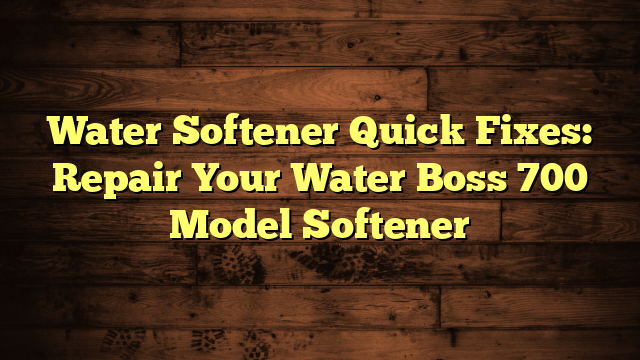Water Softener Quick Fixes: Repair Your Water Boss 700 Model Softener
You might not realize that a simple salt bridging issue can greatly hinder your Water Boss 700 softener's performance. If you've noticed decreased softness in your water, it could be time to troubleshoot a few common problems. From checking salt levels to inspecting the control valve, there are straightforward fixes that can restore functionality. Understanding these key aspects can save you time and money, but there's more to reflect upon as you work through these solutions. What steps should you prioritize to guarantee your system runs efficiently?
Key Takeaways
- Check and refill the brine tank with high-quality salt to ensure effective regeneration and prevent salt bridging issues.
- Inspect the control panel settings for accuracy and reset if necessary to resolve incorrect configurations affecting performance.
- Clean or replace clogged filters and check for blockages in the resin tank to improve water flow and pressure.
- Conduct a manual regeneration cycle to clear mineral buildup and enhance the efficiency of your Water Boss 700.
- Schedule regular maintenance every six months to clean the resin tank and inspect for leaks or wear in pipes.
Common Issues With Water Boss 700
The Water Boss 700 is a popular choice for homeowners looking to soften their water, but it's not without its common issues. Many users report concerns regarding water quality and softener efficiency. One frequent complaint is that the system doesn't seem to be softening the water as effectively as expected. This can be frustrating, especially if you notice hard water stains or buildup in your appliances.
Another common issue involves the salt level. If the salt tank isn't filled properly, the system can't regenerate effectively. When this happens, you may find that your water quality deteriorates, leaving you with hard water issues.
Furthermore, some users experience problems with the control panel, which can lead to incorrect settings and inefficient operation.
You can troubleshoot these issues by regularly checking the salt level, verifying it's topped off, and inspecting the system for any clogs. Keeping an eye on the control panel for any error messages can also help you maintain peak softener efficiency.
Identifying Salt Bridging
When you're dealing with your water softener, one common issue you might encounter is salt bridging.
This occurs when a hard crust forms above the salt in the brine tank, preventing proper salt dissolution.
Recognizing the signs and understanding the causes can help you address this problem effectively and keep your system running smoothly.
Signs of Salt Bridging
Identifying signs of salt bridging is crucial for maintaining your water softener's efficiency. Salt bridging occurs when salt buildup creates a hard crust above the brine tank, preventing the salt from dissolving properly. Regular maintenance checks can help you catch this issue early.
Here are some signs to look for:
- A noticeable salt crust on top of the salt pile
- Reduced water softening effectiveness or hard water symptoms
- Salt that appears dry or clumped, instead of being dissolved
- A lower water level in the brine tank than usual
- Unusual noises during the regeneration cycle, like banging or knocking
If you observe any of these signs, it's time to investigate further. Ignoring salt bridging can lead to inefficient softening, causing complications in your plumbing and appliances.
Regular maintenance checks will help you keep an eye on your salt levels and guarantee your water softener operates smoothly. By being proactive, you can avoid costly repairs down the line and enjoy softened water consistently.
Causes of Salt Bridging
Understanding the causes of salt bridging can help you prevent this issue from arising in the first place. One of the main culprits is excessive salt buildup in the brine tank. When salt accumulates, it can create a hard crust that traps moisture underneath. This crust prevents the salt from dissolving properly during the regeneration cycle, leading to insufficient brine production.
Another factor that contributes to salt bridging is humidity. If your brine tank is exposed to high humidity levels, moisture can seep in and cause the salt to clump together, further promoting that hard crust.
Furthermore, using the wrong type of salt can also be an issue. For example, less pure salts often contain impurities that may not dissolve as easily, increasing the likelihood of bridging.
Lastly, a dirty or improperly functioning brine tank can exacerbate the problem. Regular maintenance helps guarantee the tank operates smoothly, preventing salt from becoming compacted.
Solutions for Salt Bridging
Salt bridging can be a frustrating issue for water softener owners, but recognizing the signs early can save you time and money. When you notice unusual performance, it's important to investigate further.
Here are some common indicators of salt bridging:
- A sudden decrease in water softness
- Salt mounds or crusty layers visible in the brine tank
- An unusually high salt level that doesn't seem to deplete
- Sluggish or ineffective regeneration cycles
- Odd noises, like clattering or banging, during operation
To tackle salt bridge prevention, make sure to regularly check and maintain your water softener.
If you suspect a salt bridge, deploy troubleshooting techniques like gently breaking up the salt with a broom handle or adding hot water to the brine tank to dissolve the bridge.
Regularly cleaning and inspecting the brine tank will help keep salt bridging at bay.
Resolving Low Water Pressure
Low water pressure can be a frustrating issue when dealing with a water softener. If you're experiencing this problem, don't worry; there are several troubleshooting techniques you can try to resolve it.
First, check the bypass valve. It should be fully engaged to guarantee ideal water pressure. Next, inspect the resin tank for blockages, as these can restrict flow. A clogged filter may also be the culprit, so make sure to clean or replace it as needed.
Here's a handy table to guide you through common causes and solutions for low water pressure:
| Cause | Solution |
|---|---|
| Bypass valve not engaged | Fully engage the bypass valve |
| Clogged resin tank | Clean or replace resin |
| Dirty filter | Clean or replace the filter |
| Mineral build-up | Perform a manual regeneration |
Checking the Control Valve
The control valve plays an important role in the operation of your water softener, so it's essential to make certain it's functioning properly. Regular control valve maintenance can help prevent issues down the line.
Start by checking for any visible signs of damage or wear. Here are some things to look for:
- Cracks or breaks in the valve housing
- Leaks around the valve connections
- Blockages in the inlet or outlet ports
- Unusual noises during operation
- Error codes displayed on the control panel
If you notice any of these issues, it's time for some valve troubleshooting. First, verify the power supply to the softener is stable.
Then, inspect the valve components for debris or clogs that may be affecting performance. If you find any blockages, clean them out gently. Don't forget to check the gaskets and seals; replacing worn ones can greatly improve valve function.
Taking these proactive steps won't only enhance the efficiency of your water softener but also prolong its lifespan.
Cleaning the Resin Tank
Cleaning the resin tank is essential for maintaining your water softener's efficiency.
You'll want to use safe cleaning solutions that won't harm the resin, and setting a regular maintenance schedule can help prevent buildup over time.
Safe Cleaning Solutions
How can you guarantee that your water softener's resin tank remains in top condition? One way is by using safe cleaning solutions that won't harm your system. Two effective options are an effective vinegar solution and a baking soda cleaner. These natural ingredients aren't only safe but also powerful in keeping your resin tank clean.
Here's how you can visualize the process:
- White vinegar: Its acidity breaks down mineral buildup effortlessly.
- Baking soda: A gentle abrasive, it scrubs away stubborn deposits without scratching.
- Hot water: Boosts cleaning power and helps dissolve dirt effectively.
- Soft, clean cloth: Perfect for wiping down surfaces after cleaning.
- Measuring cup: Guarantees you use the correct proportions for your cleaning solutions.
To clean your resin tank, mix equal parts of vinegar and water, and soak for a few hours. Rinse thoroughly before using baking soda mixed with water for a final scrub.
This combination will help maintain your softener's efficiency, guaranteeing you get the best performance from your Water Boss 700 model. Maintaining a clean resin tank is essential for soft, quality water and a longer-lasting system.
Regular Maintenance Schedule
Regularly scheduling maintenance for your resin tank is essential to confirm peak performance and longevity of your water softener. To keep your Water Boss 700 running smoothly, establish a maintenance frequency that suits your water usage and local conditions. Typically, inspecting and cleaning the resin tank every six months is a good rule of thumb.
Create a maintenance checklist to confirm you cover all necessary tasks. Start by inspecting the brine tank for any salt buildup, which can hinder performance.
Next, check the resin tank for any signs of dirt or debris. A thorough cleaning can involve rinsing the resin with a gentle solution, confirming you remove any accumulated contaminants.
Don't forget to check your softener's settings and regeneration cycle—this can impact overall efficiency. If you notice any irregularities, it may be time to consult the manual or seek professional help.
Regular maintenance not only enhances the performance of your water softener but also extends its lifespan, saving you money in the long run. By staying proactive, you'll enjoy soft water that meets all your household needs.
Replacing the Brine Line
If your water softener isn't functioning properly, replacing the brine line might be a necessary step to restore its effectiveness. Over time, the brine line can develop clogs or leaks, leading to reduced performance.
Here are some replacement tips to help you through the process:
- Gather Your Tools: You'll need a wrench, replacement brine line, and cutting tool.
- Shut Off Water Supply: Make sure the water supply to the softener is turned off, preventing any mess.
- Remove Old Brine Line: Carefully detach the existing line from the brine tank and softener.
- Install the New Line: Connect the new brine line securely, making sure no kinks or bends.
- Test for Leaks: Once everything is reconnected, turn the water supply back on and check for any leaks.
Taking these steps can restore your softener's efficiency and guarantee that your water remains soft and free of mineral buildup.
Regular Maintenance Tips
Maintaining your water softener is key to keeping it running smoothly and efficiently. Regular maintenance not only prolongs the life of your Water Boss 700 model but also guarantees peak water quality.
Start by checking the salt levels in the brine tank monthly. If the salt is low, refill it with high-quality salt pellets. This helps the softener regenerate effectively.
Next, be mindful of filter replacement. Depending on your water usage and quality, you should replace the pre-filter every six months to a year. A clogged filter can impede performance, reducing your softener's effectiveness.
It's also wise to inspect the resin beads in the mineral tank. If you notice any discoloration or feel they're not performing as they should, consider replacing them.
Flushing the system regularly, about once a year, helps clear out any accumulated minerals.
Lastly, don't forget to check for leaks or signs of wear in the pipes and connectors. Addressing these issues promptly can save you from costly repairs down the line.
Frequently Asked Questions
How Often Should I Replace the Resin in My Water Boss 700?
You should replace the resin in your water softener every 5 to 10 years, depending on usage. A resin lifespan varies, so keep an eye on performance and replace it when you notice reduced efficiency.
Can I Use Regular Table Salt in My Water Softener?
You shouldn't use regular table salt in your softener. It can harm the system and reduce efficiency. Instead, opt for salt alternatives specifically designed for water softeners to maintain ideal performance and longevity.
What Are the Signs of a Failing Control Valve?
You'll notice malfunction symptoms if your control valve is failing. Look for water flow issues, unusual noises, or leaks. If you see these signs, it's essential to address the problem before it worsens.
Is It Safe to Use Hot Water During Regeneration?
About 60% of households use hot water daily. During the regeneration process, it's generally safe to use hot water, but you should limit heavy usage to guarantee your softener operates effectively without interruptions.
How Do I Reset My Water Boss 700 After a Power Outage?
After a power outage, you'll need to follow the reset procedure. Simply unplug the unit for about 10 seconds, then plug it back in. Make sure to check settings to verify everything's functioning correctly.
Conclusion
By addressing common issues like salt bridging and low water pressure, you can keep your Water Boss 700 running smoothly. Remember, about 85% of American households have hard water, making regular maintenance essential for extending your softener's lifespan. With a little attention, you can enhance your water quality and enjoy the benefits of soft water without hassle. Stay proactive, and don't hesitate to perform these quick fixes to guarantee your system operates efficiently.







